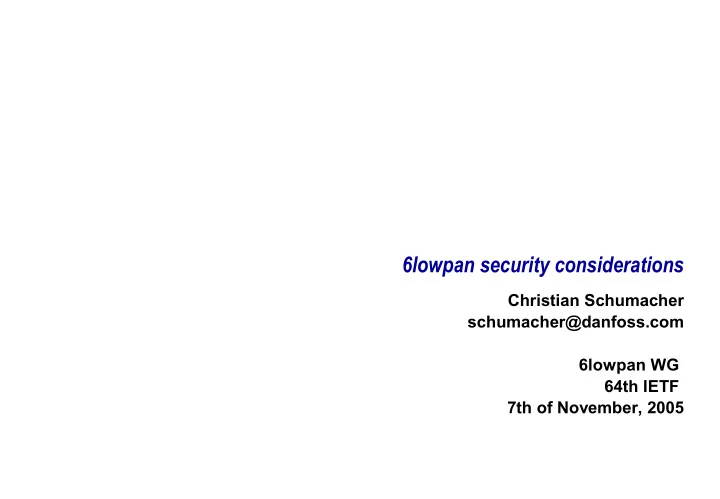

6lowpan security considerations Christian Schumacher schumacher@danfoss.com 6lowpan WG 64th IETF 7th of November, 2005
Disposition 6lowpan problem areas and scope Current security considerations IEEE802.15.4 2003 specification Application scenario (6lowpan and the world) 6lowpan and key management Suggestions
6lowpan problem areas and scope General problem areas identified: – IP adaptation/Packet Formats and interoperability – Addressing schemes and address management – Network management – Routing in dynamically adaptive topologies – Security, including set-up and maintenance – Application programming interface – Discovery (of devices, of services, etc) – Implementation considerations Security problem areas identified ( http://6lowpan.tzi.org/SecurityObjectives ) – Authorization • Why devices are supposed to talk – Key management • Setting up network, Life-cycle issues Current scope / charter – Problem statement document (with security considerations) – Format of IPv6 packets document (with security considerations)
Current security considerations Quotes from draft-6lowpan-problem-01 – “End-to-end security is needed.” – ”Bootstrapping of devices into a secure network…” – “6LoWPAN imposes unique set of challenges…” – “IEEE 802.15.4 provides AES link layer security…” Quotes from draft-6lowpan-format-01 – “…security for such devices (RFDs) may rely quite strongly on the mechanisms defined at the link-layer by IEEE 802.15.4.” – ”…[IEEE802.15.4] does not, in particular, specify key management…”
IEEE802.15.4 2003 specification Security issues with IEEE802.15.4 2003 spec – Paper by Naveen Sastry and David Wagner indicates that 2003 spec. has many pitfalls. • Download ”Security Considerations for IEEE 802.15.4 Networks” from http://www.cs.berkeley.edu/~daw/papers/ IEEE802.15.4b WG – This WG aims to clarify ambiguities and pitfalls in original IEEE802.15.4 2003 spec. – WG is also specifying new PHY modes, which may make 802.15.4b more attractive. – WG is resolving security pitfalls identified by the before mentioned paper. – Specification should be available for download July 2006 Main differences between 802.15.4b security and legacy 802.15.4-2003 security (input from Rene Struik, security expert from Certicom) – Protection of broadcast and multicast frames possible – Easier setup of protection parameters possible – Possibility to vary protection per frame, using a single key – Consideration of system lifecycle issues – Optimization of storage for keying material
Application scenario (6lowpan and the world) IPv6 over 802.15.4 IPv4 / IPv6 over Foo (e.g. Ethernet) P FFD Some #2 RFD Device #2 #1 FFD #1 RFD (Gateway) #4 Some Device #1 RFD #2 RFD #3 Layers in TCP/IP Security for Foo Security for 802.15.4 Application TLS (SSL) * Undefined Transport TLS (SSL) * Undefined Network IPSec / Foo (802.15.4) Link Foo 802.15.4 * Operates between Application and Transport layer
Application scenario (6lowpan and the world) IPv6 over 802.15.4 IPv4 / IPv6 over Foo (e.g. Ethernet) P FFD Some #2 RFD Device #2 #1 FFD #1 RFD (Gateway) #4 Some Device #1 RFD #2 RFD #3 Secure communications between ”Some Device on Foo” and a ”Device on IEEE802.15.4” is most likely to happen thru a gateway. This gateway will handle TLS / IPSec on the Foo network and a utilize a To-Be-Defined security protocol on the 802.15.4 network. With TLS / IPSec there are protocols for negotiating keys (key-management) on the fly. With 802.15.4 security these protocols are missing. Ad-hoc wireless networks require secure communications on-the-fly!
6lowpan and key management First of all: We need input from security experts! What methods could be used for exchanging keys? – Bootstrapping keys • Logistical nightmare (trust your manufacturer for book-keeping of keys) • Maintenance issues (how to renew keys?) • Resellability – Unencrypted key exchange, accept moment of vulnerability • Will work, but no guarantee of security • Careless implementation could lead to easy access to keys – Public-key based methods • What technology to use (RSA, ECC)
Suggestions Advocate IEEE802.15.4b and amend current security considerations to reflect this decision. Recharter to work on document(s) which focus on key-management – Where to get inspiration? • SNMP v3 security models ( RFC 3411, RFC 3418 ) • SSL on 8-bit processors ( http://www.embedded.com/showArticle.jhtml?articleID=45400043 ) • IETF security WGs • Security experts input ( e.g. papers on sensor networks by David Wagner, http://www.cs.berkeley.edu/~daw/papers/ )
Recommend
More recommend